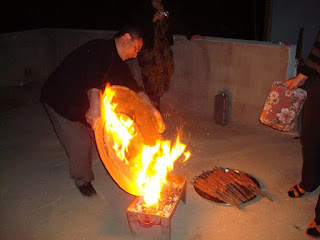 Saturday, April 4, 2009
Saturday, April 4, 2009As we get ready to head home tomorrow, last night it was time to say goodbye to Ahmed Haji. At nearly 79, Ahmed Haji began his service with the Kurdish peshmerga as part of the Republic of Mahabad in 1945. Although he retired from peshmerga service years ago, he continues to work part-time in his retirement as a "village elder" in the countryside. A Christian "village elder" serves as his counterpart, and together the two of them help to mediate disputes between villagers in a region about 2 hours from Erbil.
This time it seemed harder saying goodbye--not knowing when, or if, we will see him again.



 Thus, it was with great with relief that we found that large portions of the original bazaar are still intact--wires still hang everywhere, uneven pavement is still a hazard, carts exist for a variety of food items, and lots and lots of local flavor remain--which the new mall, however elegant, will never have.
Thus, it was with great with relief that we found that large portions of the original bazaar are still intact--wires still hang everywhere, uneven pavement is still a hazard, carts exist for a variety of food items, and lots and lots of local flavor remain--which the new mall, however elegant, will never have.



